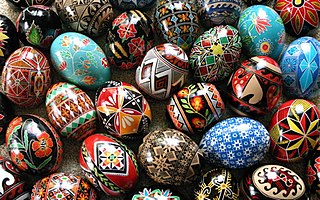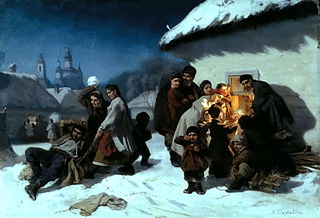 W
WBabinden is a traditional Bulgarian feast, celebrated on 8 January, in honour of the women practicing midwifery. The traditional word for midwife in Bulgarian is baba, same as grandmother. The holiday has pagan origins and is part of the traditional family rituals.
 W
WThe badnjak, also called veseljak, is a tree branch or entire tree that is central to Serbian Christmas celebrations. It is placed on a fire on Christmas Eve and its branches are later brought home by worshipers. The tree from which the badnjak is cut, preferably a young, straight and undamaged Austrian oak, is ceremonially felled early on the morning of Christmas Eve. The felling, preparation, bringing in, and laying on the fire, are surrounded by elaborate rituals, with many regional variations. The burning of the log is accompanied by prayers that the coming year brings food, happiness, love, luck, and riches. The log burns on throughout Christmas Day, when the first visitor strikes it with a poker or a branch to make sparks fly, while wishing that the family's happiness and prosperity be as abundant as the sparks. As most Serbs today live in towns and cities, the badnjak is often symbolically represented by a cluster of oak twigs with brown leaves attached, with which the home is decorated on Christmas Eve.
 W
WBread and salt is a welcome greeting ceremony in some Slavic, Nordic, Baltic, Balkan and other European cultures as well as in Middle Eastern cultures. The tradition, known by local Slavic names, is also shared with some non-Slavic nations — Lithuanians, Latvians, Romanians (Romance) as well as some Finno-Ugric peoples like the Karelians — all of which are culturally and historically close to their Slavic neighbours. It is also common in Albania, Armenia, the Jewish diaspora, and the Middle East. This tradition has also been observed in spaceflight.
 W
WDodola, also known under the names for butterfly: Paparuda, Peperuda, Perperuna or Preperuša, is a pagan tradition found in the Balkans. The central character of the ceremony is usually an orphan girl, less often, a boy. Wearing a skirt made of fresh green knitted vines and small branches, the girl born after the death of her father, the last girl child of the mother, sings and dances through the streets of the village, stopping at every house, where the hosts sprinkle water on her. The ritual is associated with a particular tune to which a particular dance is performed, not only by the girl, but also by the villagers who follow her through the streets, shouting their encouragement.
 W
WThe tradition of egg decoration in Slavic cultures originated in pagan times, and was transformed by the process of religious syncretism into the Christian Easter egg. Nevertheless, these decorated eggs have retained much of their pagan symbolism.
 W
WKoledari are Slavic traditional performers of a ceremony called koleduvane, a kind of Christmas caroling. It is associated with Koliada, a celebration incorporated later into Christmas.
 W
WKoliada or koleda is the traditional Slavic name for the period from Christmas to Epiphany or, more generally, to Slavic Christmas-related rituals, some dating to pre-Christian times. It represents a festival or holiday, celebrated at the end of December to honor the sun during the winter solstice. It also involves groups of singers who visit houses to sing carols.
 W
WLazarice, also known by its Bulgarian name Lazaruvane, is a traditional procession during the Eastern Orthodox feast of Lazareva Subota, the day before Palm Sunday. Traditionally, a girl who has never participated in the ritual may not marry or be engaged.
 W
WLazarus Saturday in Eastern Christianity refers to the moveable feast before Palm Sunday to which it is liturgically linked. It celebrates the raising of Lazarus of Bethany. Bethany is recorded in the New Testament as a small village in Judaea, the home of the siblings Mary of Bethany, Martha, and Lazarus, as well as that of Simon the Leper. John's gospel reports that "Six days before the Passover, Jesus came to Bethany, where Lazarus lived, whom Jesus had raised from the dead." Presumably, it is where he spent the Great Sabbath that occurs immediately before Passover, prior to his triumphal entry into Jerusalem. Jesus is reported to have lodged there during Holy Week, and it is where his anointing by Lazarus' sister Mary took place a few days later on Holy Wednesday.
 W
WSaint Demetrius of Thessaloniki, also known as the Holy Great-Martyr Demetrius the Myroblyte, was a Christian martyr of the early 4th century AD.
 W
WSaint Nicholas Day, also called the Feast of Saint Nicholas, is observed on 6 December or on 5 December in Western Christian countries, and on 19 December in Eastern Christian countries using the old church Calendar. It is the feast day of Nicholas of Myra with particular regard to his reputation as a bringer of gifts.
 W
WSerbian Christmas traditions are customs and practices of the Serbs associated with Christmas and a period encompassing it, between the third Sunday before Christmas Day and Epiphany. There are many, complex traditions connected with this period. They vary from place to place, and in many areas have been updated or watered down to suit modern living. The Serbian name for Christmas is Božić, which is the diminutive form of the word bog ("god"), and can be translated as "young god". Christmas is celebrated for three consecutive days, starting with Christmas Day, which the Serbs call the first day of Christmas. On these days, one is to greet another person by saying "Christ is Born," which should be responded to with "Truly He is Born," or in Serbian: "Hristos se rodi" [ˈxristɔs sɛ ˈrɔdi] – "Vaistinu se rodi" [ˈʋaistinu sɛ ˈrɔdi].
 W
WSlava is a Serbian Orthodox Christian tradition of the ritual of glorification of one's family's patron saint. The family celebrates the Slava annually on the saint's feast day. In November 2014 it was inscribed in UNESCO Intangible Cultural Heritage Lists of Serbia.
 W
WSlavic carnivals are known under different names in various Slavic countries: Macedonian: Прочка, romanized: Prochka, Bulgarian:Сирни заговезни, Прошка, Russian: Масленица, Мясопуст, Polish: Ostatki, Mięsopust, Zapusty, Czech: Masopust, Šibřinky, Ostatky, Slovak: Fašiangy, Slovene: Mesopȗst, Pust, Pustni teden, Fašnk, Serbian: Покладе, Poklade, Croatian: Pust, Poklade, Mesopust, Fašnik. They are traditional Slavic festivals related to the period of carnival.
 W
WŚmigus-dyngus is a Roman Catholic celebration held on Easter Monday across Central Europe, and in small parts of Eastern and Southern Europe. The tradition is widely associated with Poland and is observed by Polish Diaspora communities, particularly among Polish Americans who call it Dyngus Day.
 W
WVidovdan is a Serbian national and religious holiday, a slava celebrated on 28 June, or 15 June according to the Julian calendar. The Serbian Church designates it as the memorial day to Saint Prince Lazar and the Serbian holy martyrs who fell during the Battle of Kosovo against the Ottoman Empire on 15 June 1389. It is an important part of Serb ethnic and Serbian national identity.
 W
WZaduszki or Dzień Zaduszny is a Polish name of All Souls' Day, a Catholic holiday celebrated on 2 November, a day after All Saint's Day. The word Zaduszki originating from Dzień Zaduszny, can be roughly translated into English as "the day of prayers for the souls". On this day people visit cemeteries to light candles and pray for the souls of the dead, especially those believed to be in purgatory.
 W
WA zapis is a sacred tree in Serbian tradition, protecting the village within whose bounds it is situated. A cross is inscribed into the bark of each zapis. Most of these trees are large oaks. Prayers are offered to God under the crown of the zapis, where church services may also be held, especially during village festivals observed to supplicate God for protection against destructive weather conditions. In settlements without a church, ceremonies such as weddings and baptisms were once conducted under the tree. Folk tradition maintains that great misfortune will befall anyone that dares fell a zapis. According to Serbian scholar Veselin Čajkanović, the zapis is inherited from the pre-Christian religion of the Serbs, in which it had been used as a temple.